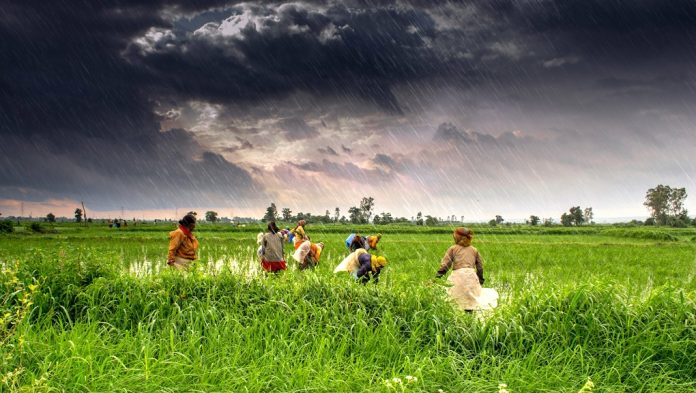This article is authored by Akash Krishnan, a law student from ICFAI Law School, Hyderabad. It discusses in detail the effect of global warming across the world, the proceedings of CoP 26 and its impact on tackling climate change.
Table of Contents
Introduction
Three degrees can be the difference between snow and sleet and wearing a jacket or not. In simple words, three degrees of global warming would be catastrophic and would result in heatwaves, droughts, extreme precipitation and even natural fires across the globe. The scary thing is that the world is well on its way there. Since the industrial revolution, the Earth has warmed between 1.1 degrees celsius and 1.3 degrees celcius. Many rural parts of the world have suffered disproportionately over the years. Small-scale farmers are particularly vulnerable to climate change and there are over 600 million farmers around the world. Small-scale farmers with farmland of under 2 hectares produce around a third of the global food supply. Imagine living in a world where these farmers are no longer able to meet the global food needs because of climate change and you will have the answer to the question as to how climate change can affect your very basic needs for survival.
Over the years the United Nations Framework Convention on Climate Change has held several conferences to resolve the issue of climate change and the 26th Conference of Parties (CoP 26) that was held in Glasgow from October 31st to 13th November was one of the most recent conferences in this regard. The goal of this conference was to make countries commit to individual goals so that global warming does not exceed 1.5 degrees celsius. Let us now look into the proceedings of the conference and what was the final outcome.
A brief summary of CoP 26
It was supposed to be the summit that would stop global warming but now there is deep disappointment with environmentalists saying CoP 26 fell short of the urgent action that’s needed. Negotiations in Glasgow went on beyond the deadline as draft after draft came closer to producing a global agreement to restrict greenhouse gases. But the final document was met with anger after India scuppered its key provision to phase out coal power.
The COP 26 summit began with hopes to save the planet and ended with an apology from the President of the United Nations Climate Change Conference wherein he stated that the expected results were not met and he was sorry for the disappointment caused to the world at large. Delegates did manage to come to an agreement at the end of the conference which has been seen as a final hour, last-ditch effort to stop catastrophic climate change. Most countries agreed on new and more ambitious targets for reducing emissions but the pledges fell short of what science says is needed to stop the world from heating beyond a dangerous 1.5-degrees celsius. India insisted on a last-minute watering down of the final text changing references of a coal phase-out to a coal phase down. Wealthy nations resisted calls to create a mechanism to compensate poor countries suffering the worst effects of climate change.
UN Secretary-General Antonio Guterres urged countries to do more. He stated that there was an urgent need to accelerate global actions so that the goal of less than 1.5 degrees celsius global heat is kept alive. He further stated that nations should go into emergency mode or else the world will soon be knocking on the doors of a climate catastrophe. World leaders agreed to reconvene in Egypt for talks next year where major emitters will be asked to present new targets. But with the goal of 1.5 degrees celsius now on life support, activists say that CoP 27 is already dead.
On the actual issue of the watering down of the phase-out of coal provisions, experts state that the mechanism adopted under COP 26 is not what the world needs to achieve a 1.5-degree celsius goal. The text around fossil fuels was even more dubious because it was only looking forward to cutting out inefficient subsidies and not cutting down the use of fossil fuels itself. Governments in the bigger emitter countries had turned to a set of policies that were not in line with how climate issues needed to be dealt with.
India’s effort to water down the coal phase-out is being debated across the world. From an Indian perspective, they had tried to force developed countries to make commitments that they owe to the rest of the world. India has insisted that they are making commitments despite serious developmental challenges. Prime Minister Narendra Modi stated that India will adopt a five staged process, i.e., the “panchamrit” in its attempt to combat climate change. The five stages include raising the non-fossil fuel-based energy capacity of the country to 500 GW by 2030, using renewable sources of energy to satisfy half the counties energy requirements, reducing the carbon emissions by 1 billion tonnes by 2030, reducing the carbon intensity of the economy to 45% by 2030 and cut down carbon emissions to zero by the year 2070. India stated that this shows its commitment to mitigating climate change despite the challenges it is facing as a developing country but it is entitled to the responsible use of coal which is why the language watering down was pushed for.
Rich nations have been reluctant to agree to any mechanism to provide funding for the loss and damage caused to the climate. From an Indian perspective, this has caused and contributed to a trust deficit especially when a hundred million dollar commitment to mitigate climate change in developing countries was missed in 2020. India insists that developed countries grew as a consequence of their heavy reliance on coal and that these developing countries who are understanding what climate change is should be allowed to use coal responsibly. Simply put, it’s a case of alleging that the developed countries grew over the last 70-80 years by relying on the use of coal but now are insisting that India and other developing countries should be doing more by committing to cuts in carbon emissions. This has led to resentment and pushback from developing countries in CoP 26. However, India insisted that it is doing more than it can by committing to these climate change goals.
Glasgow Climate Pact
Over 197 countries across the world participated in this conference and signed an agreement to ensure the protection and preservation of climate so as to meet the 1.5-degree celsius goal. The relevant portions of the Climate Pact have been enumerated below:
Science and urgency
- The Pact recognised the importance and need of the best available scientific technologies and innovations to combat climate change.
- It welcomed the contributions of Working Group I to the Intergovernmental Panel on Climate Change and several other Intergovernmental Panels and International organisations regarding advanced technological measures that could be adopted.
- It expressed concern over the increasing global warming and stressed the urgency of coming up with an action plan to deal with it and to mitigate activities causing carbon emissions in the future.
Adaptation
- It noted that with every passing moment, any activity that causes carbon emissions will contribute to the increase in temperature globally thereby causing adverse effects on the common people of the world.
- It emphasised the need for finance, capacity-building and technology transfer, to enhance adaptive capacity, strengthen resilience and reduce vulnerability to climate change in line with the best available science, taking into account the priorities and needs of developing countries and welcomed countries to submit adaptation plans in this regard.
Adaptation finance
- It noted that developing and under-developed countries are not equipped with sufficient funds to tackle the issue and effects of climate change.
- It urged the developed countries to come together and set up an action plan so as to help the developing and under-developed countries by assisting them in climate finance, technology transfer and capacity-building processes.
- It recognised the need and urgency for climate finance and stated that developed countries should try and increase their funding towards the climate adaptation funds and help the developing and under-developed countries to use these funds to adapt to climate change more quickly.
- It also emphasised the need for multilateral development banks, other financial institutions and the private sector to provide finances and other resources that were required to achieve the climate adaptation plans globally.
Mitigation
- It noted that there was an urgent need to limit the temperature increase to 1.5 °C above pre-industrial levels as this would help reduce the effects and risks associated with climate change globally and also noted that all nations should work together to achieve this global target.
- To meet this goal, it suggested that there should be a sustained reduction in the emissions of greenhouse gasses and that carbon emissions should be brought down to at least 45% by the year 2030 so that by 2050, the global carbon emissions can be brought down to zero.
- It called for a collective action that has to be taken by the nations to reduce non-carbon dioxide greenhouse gas emissions, including methane by the year 2030.
- It recommended that nations should adopt low-energy emissions systems and renewable energy sources to boost the effort towards climate change.
- It recommended the phase-down of unabated coal power and the phase-out of inefficient fossil fuel subsidies.
- It also emphasised the need to maintain forests and increase green cover globally so that this acts as a natural sink or reservoir of greenhouse gases.
Loss and damage
- It recognised that, with time, the effects of climate change will increase thereby causing loss to life and property. The increase in temperature will pose a social, economic and environmental threat globally.
- It emphasised the role of all the stakeholders including the indigenous people and local communities to battle the adverse effects of climate change and to protect the environment.
- It urged that nations should support each other by providing appropriate climate financing, technology transfer and capacity building mechanisms so as to help the nations in the establishment of mechanisms to avert, minimise and address the loss and damage that they may suffer due to climate change.
- It urged developed countries, the operating entities of the Financial Mechanism, United Nations entities and intergovernmental organizations and other bilateral and multilateral institutions, including non-governmental organizations and private sources, to provide enhanced and additional support for activities addressing loss and damage associated with the adverse effects of climate change
Implementation
- It emphasised the need for all nations to implement and continue to work on the targets that had been set in 2018, 2019 and 2020 and also to work towards establishing new targets to combat climate change.
- It urged all the nations to meet with all the outstanding pledges without any undue delay as soon as possible.
- It emphasised the need to incorporate the concerns of the developing countries while cutting down the emission levels in line with the importance of adopting an immediate action plan to combat climate change. In doing so, it encouraged the nations to form both national and local level policies so that the carbon emissions can be controlled at every level.
- It recognised the importance of protecting, conserving and restoring ecosystems to deliver crucial services, including acting as sinks and reservoirs of greenhouse gases, reducing vulnerability to climate change impacts and supporting sustainable livelihoods, including for indigenous peoples and local communities
- It recognised the need to promote sustainable development and the creation of quality jobs while keeping in mind the need to reduce greenhouse gases and shutting down industries exclusively engaging in these activities.
Conclusion
India is facing the consequences of climate change and there have been several recent extreme climatic changes around the country like floods, cyclones etc. There is not only a loss of life and property but there could also be potential loss of land as land is getting submerged as a consequence of climate change. According to data, if India misses the 1.5. degree celsius goal, it would be fatal to survive outside in the bigger cities for more than three to four hours because of the increase in temperatures. Today, the Indian government almost has to negotiate a trade-off. India has suffered massively due to the coronavirus lockdowns and it is a question of how much of today can be traded off for the future.
Although the targets that were set for this CoP are far from met, we can only hope that the CoP that is scheduled for next year will help in the formation of a policy that would help the world reach the goal of 1.5 degrees celsius.
References
- https://www.downtoearth.org.in/news/climate-change/the-latest-cop26-decision-draft-urges-and-urges-and-then-deeply-regrets-80187
- https://www.bbc.com/news/science-environment-59263761
- https://indianexpress.com/article/explained/explained-key-takeaways-cop26-glasgow-climate-pact-7621847/
- https://unfccc.int/news/cop26-reaches-consensus-on-key-actions-to-address-climate-change
LawSikho has created a telegram group for exchanging legal knowledge, referrals, and various opportunities. You can click on this link and join:
https://t.me/joinchat/J_0YrBa4IBSHdpuTfQO_sA
Follow us on Instagram and subscribe to our YouTube channel for more amazing legal content.
 Serato DJ Crack 2025Serato DJ PRO Crack
Serato DJ Crack 2025Serato DJ PRO Crack











 Allow notifications
Allow notifications



